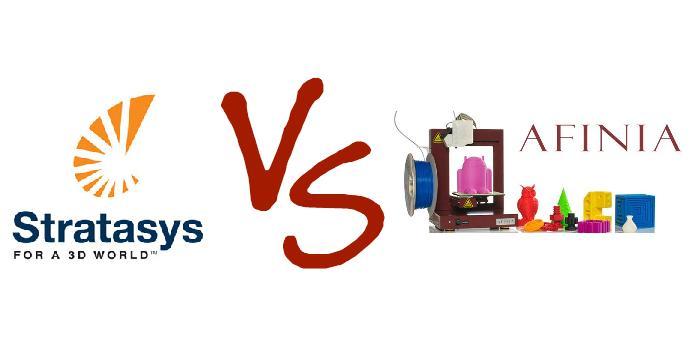Stratasys Vs Afinia Patent Case Drama: Stratasys drops one of its 3D printer patent violation allegations
With the rapid growth of 3D printing, attributed mainly to the sheer number of companies manufacturing printers, and the DIY kits which are available at affordable prices, there has been only one thing seemingly getting  in the way of this explosive expansion of the market — patents. Patents are used to protect intellectual property and inventions, but at the same time give the grantee a temporary monopoly over that invention, typically for 20 years. While monopolistic behavior normally stifles innovation, the idea of a patent spawns innovation as companies strive to obtain them.
in the way of this explosive expansion of the market — patents. Patents are used to protect intellectual property and inventions, but at the same time give the grantee a temporary monopoly over that invention, typically for 20 years. While monopolistic behavior normally stifles innovation, the idea of a patent spawns innovation as companies strive to obtain them.
Within any industry there are patent disputes, which can drag on into long, complicated, expensive legal battles between two or more companies. One such dispute which erupted last year, was between 3D printing giant Stratasys, and that of another 3D printer manufacturer, Afinia, owned by Microboards Technology LLC. Stratasys had actually accused Afinia of violating four of its patents, and is set to meet in trial on December 1st of this year.
Since then, however, Afinia has challenged all four of the patent violation complaints. It has been revealed in court filings that just a couple weeks ago, Stratasys was forced to dropped one of the violation allegations. The patent in question is US-5653925A, which defined a method for controlling the porocity of 3D models. In layman’s terms, it was a patent which controlled the infill of a 3D printed object. What Afinia argued in their  challenge to Stratasys’ allegations was that a patent for that process had already been granted in the past, meaning that this new patent, granted to Stratasys in 1997 ,should be deemed to be invalid. To make things even worse for Stratasys’ case, the patent which Afinia claims invalidates US-5653925A, was also granted to Stratasys years prior.
challenge to Stratasys’ allegations was that a patent for that process had already been granted in the past, meaning that this new patent, granted to Stratasys in 1997 ,should be deemed to be invalid. To make things even worse for Stratasys’ case, the patent which Afinia claims invalidates US-5653925A, was also granted to Stratasys years prior.
Afinia responded to the allegations with material backing up their stance, in additional to a counterclaim which sought to invalidate this patent altogether. On top of this, they are also claiming that Startasys’ actions constituted inequitable conduct and patent misuse, since they should have realized that they were double patenting their own invention. Stratasys responded with the offer to dismiss any claims of infringement related to this particular patent, if Afinia would drop their counterclaim. Afinia refused.
On July 11th the courts ordered Stratasys to drop their claim against Afinia for US 5653925A. In addition they will look further at the counterclaims submitted by Afinia at a later date.
Stratasys still has three patents which it alleges were violated by Afinia, of which an outcome will eventually be determined. These patents include inventions which allow for a heated build environment, an extrusion process, as well as a seam concealment method. The ultimate ruling by the court could have major implications on the entire desktop 3D printing market. We should know much more by the end of this year.
Let’s hear your thoughts on this court battle in the Stratasys Vs. Afinia forum thread on 3DPB.com.
[Source: Makezine]Subscribe to Our Email Newsletter
Stay up-to-date on all the latest news from the 3D printing industry and receive information and offers from third party vendors.
You May Also Like
Gorilla Sports GE’s First 3D Printed Titanium Cast
How do you help a gorilla with a broken arm? Sounds like the start of a bad joke a zookeeper might tell, but it’s an actual dilemma recently faced by...
Nylon 3D Printed Parts Made More Functional with Coatings & Colors
Parts 3D printed from polyamide (PA, Nylon) 12 using powder bed fusion (PBF) are a mainstay in the additive manufacturing (AM) industry. While post-finishing processes have improved the porosity of...
$25M to Back Sintavia’s Largest Expansion of Metal 3D Printing Capacity Since 2019
Sintavia, the digital manufacturing company specializing in mission-critical parts for strategic sectors, announced a $25 million investment to increase its production capacity, the largest expansion to its operations since 2019....
Velo3D Initiates Public Offering in a Bid to Strengthen Financial Foundations and Drive Future Growth
Velo3D (NYSE: VLD) has been among a number of publicly traded 3D printing firms that have attempted to weather the current macroeconomic climate. After posting a challenging financial report for 2023,...
































